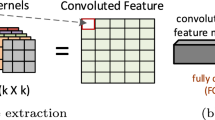Abstract
We propose a novel optoelectronic deep neural network (OE-DNN) hardware called the self-referential holographic deep neural network (SR-HDNN). The SR-HDNN features a combination of an optical computing part utilizing a volume hologram and an electronic part connecting the optical elements virtually. Since the shape of a volume hologram, which is a 3-dimensional (3D) refractive index distribution in this case, can be changed by its recording conditions, it is expected to realize the flexible design of optical computing functions by coupling between specific nodes. In addition, the electronic part enables the construction of multi-layer networks without extending the optical system and enabling arbitrary signal processing, including nonlinear operations. By integrating flexible optical and electronic parts, the SR-HDNN consisting of both flexible optical and electronic parts has the potential to maximize the performance of OE-DNN. In this study, we numerically simulate image classification tasks to investigate the feasibility and potential of the SR-HDNN.












Similar content being viewed by others
Data availability
All data supporting the findings of this study are available from the corresponding author upon reasonable request.
References
Lin, X., Rivenson, Y., Yardimci, N.T., Veli, M., Luo, Y., Jarrahi, M., Ozcan, A.: All-optical machine learning using diffractive deep neural networks. Science 361(6406), 1004–1008 (2018). https://doi.org/10.1126/science.aat8084
Wu, Z., Zhou, M., Khoram, E., Liu, B., Yu, Z.: Neuromorphic metasurface. Photon. Res. 8(1), 46–50 (2020). https://doi.org/10.1364/PRJ.8.000046
Chang, J., Sitzmann, V., Dun, X., Heidrich, W., Wetzstein, G.: Hybrid optical-electronic convolutional neural networks with optimized diffractive optics for image classification. Sci. Rep. 8(1), 12324 (2018). https://doi.org/10.1038/s41598-018-30619-y
Miscuglio, M., Hu, Z., Li, S., George, J.K., Capanna, R., Dalir, H., Bardet, P.M., Gupta, P., Sorger, V.J.: Massively parallel amplitude-only Fourier neural network. Optica 7(12), 1812–1819 (2020). https://doi.org/10.1364/OPTICA.408659
Shi, W., Huang, Z., Huang, H., Hu, C., Chen, M., Yang, S., Chen, H.: Loen: Lensless opto-electronic neural network empowered machine vision. Light: Sci. Appl. 11(1), 121 (2022). https://doi.org/10.1038/s41377-022-00809-5
Sadeghzadeh, H., Koohi, S.: Translation-invariant optical neural network for image classification. Sci. Rep. 12(1), 17232 (2022). https://doi.org/10.1038/s41598-022-22291-0
Rafayelyan, M., Dong, J., Tan, Y., Krzakala, F., Gigan, S.: Large-scale optical reservoir computing for spatiotemporal chaotic systems prediction. Phys. Rev. X 10, 041037 (2020). https://doi.org/10.1103/PhysRevX.10.041037
Dou, H., Deng, Y., Yan, T., Wu, H., Lin, X., Dai, Q.: Residual D2NN: training diffractive deep neural networks via learnable light shortcuts. Opt. Lett. 45(10), 2688–2691 (2020). https://doi.org/10.1364/OL.389696
Rahman, M.S.S., Li, J., Mengu, D., Rivenson, Y., Ozcan, A.: Ensemble learning of diffractive optical networks. Light: Sci. Appl. 10(1), 14 (2021). https://doi.org/10.1038/s41377-020-00446-w
Gu, Z., Gao, Y., Liu, X.: Optronic convolutional neural networks of multi-layers with different functions executed in optics for image classification. Opt. Express 29(4), 5877–5889 (2021). https://doi.org/10.1364/OE.415542
Zhou, T., Lin, X., Wu, J., Chen, Y., Xie, H., Li, Y., Fan, J., Wu, H., Fang, L., Dai, Q.: Large-scale neuromorphic optoelectronic computing with a reconfigurable diffractive processing unit. Nat. Photonics 15(5), 367–373 (2021). https://doi.org/10.1038/s41566-021-00796-w
Takabayashi, M., Okamoto, A.: Self-referential holography and its applications to data storage and phase-to-intensity conversion. Opt. Express 21(3), 3669–3681 (2013). https://doi.org/10.1364/OE.21.003669
Popoff, S.M., Lerosey, G., Carminati, R., Fink, M., Boccara, A.C., Gigan, S.: Measuring the transmission matrix in optics: an approach to the study and control of light propagation in disordered media. Phys. Rev. Lett. 104, 100601 (2010). https://doi.org/10.1103/PhysRevLett.104.100601
Popoff, S., Lerosey, G., Fink, M., Boccara, A.C., Gigan, S.: Image transmission through an opaque material. Nat. Commun. 1(1), 81 (2010). https://doi.org/10.1038/ncomms1078
Lecun, Y., Bottou, L., Bengio, Y., Haffner, P.: Gradient-based learning applied to document recognition. Proc. IEEE 86(11), 2278–2324 (1998). https://doi.org/10.1109/5.726791
Hao, J., Lin, X., Chen, R., Lin, Y., Liu, H., Song, H., Lin, D., Tan, X.: Phase retrieval combined with the deep learning denoising method in holographic data storage. Opt. Continuum 1(1), 51–62 (2022). https://doi.org/10.1364/OPTCON.444882
Katano, Y., Nobukawa, T., Muroi, T., Kinoshita, N., Ishii, N.: Efficient decoding method for holographic data storage combining convolutional neural network and spatially coupled low-density parity-check code. ITE Trans. Media Technol. Appl. 9(3), 161–168 (2021). https://doi.org/10.3169/mta.9.161
Katano, Y., Muroi, T., Kinoshita, N., Ishii, N., Hayashi, N.: Data demodulation using convolutional neural networks for holographic data storage. Jpn. J. Appl. Phys. 57(9S1), 09SC01 (2018). https://doi.org/10.7567/JJAP.57.09SC01
Shimobaba, T., Kuwata, N., Homma, M., Takahashi, T., Nagahama, Y., Sano, M., Hasegawa, S., Hirayama, R., Kakue, T., Shiraki, A., Takada, N., Ito, T.: Convolutional neural network-based data page classification for holographic memory. Appl. Opt. 56(26), 7327–7330 (2017). https://doi.org/10.1364/AO.56.007327
Sakib Rahman, M.S., Ozcan, A.: Computer-free, all-optical reconstruction of holograms using diffractive networks. ACS Photonics 8(11), 3375–3384 (2021). https://doi.org/10.1021/acsphotonics.1c01365
Li, Y., Luo, Y., Bai, B., Ozcan, A.: Analysis of diffractive neural networks for seeing through random diffusers. IEEE J. Select. Topics Quantum Electron. (2022). https://doi.org/10.1109/JSTQE.2022.3194574
Acknowledgements
We would like to thank Prof. Atsushi Shibukawa at Hokkaido University for the fruitful comments on the transmission matrix. We also acknowledge thank Editage (www.editage.com) for English language editing.
Author information
Authors and Affiliations
Corresponding author
Ethics declarations
Conflict of interest
The authors declare that they have no conflict of interest.
Additional information
Publisher’s Note
Springer Nature remains neutral with regard to jurisdictional claims in published maps and institutional affiliations.
Rights and permissions
Springer Nature or its licensor (e.g. a society or other partner) holds exclusive rights to this article under a publishing agreement with the author(s) or other rightsholder(s); author self-archiving of the accepted manuscript version of this article is solely governed by the terms of such publishing agreement and applicable law.
About this article
Cite this article
Tomioka, R., Takabayashi, M. Numerical simulations on optoelectronic deep neural network hardware based on self-referential holography. Opt Rev 30, 387–396 (2023). https://doi.org/10.1007/s10043-023-00810-2
Received:
Accepted:
Published:
Issue Date:
DOI: https://doi.org/10.1007/s10043-023-00810-2




